
Ordsall Hall is a large former manor house in the historic parish of Ordsall, Lancashire, England, now part of the City of Salford, in Greater Manchester. It dates back more than 750 years, although the oldest surviving parts of the present hall were built in the 15th century. The most important period of Ordsall Hall's life was as the family seat of the Radclyffe family, who lived in the house for more than 300 years. The hall was the setting for William Harrison Ainsworth's 1842 novel Guy Fawkes, written around the plausible although unsubstantiated local story that the Gunpowder Plot of 1605 was planned in the house.
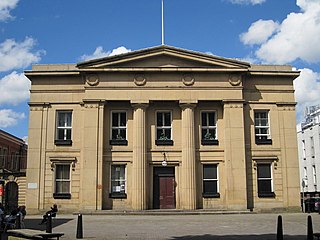
Salford is a city in Greater Manchester, England. The city is situated in a meander on the western bank of the River Irwell which forms its boundary with Manchester and its city centre. Landmarks in the city include the 100 Greengate skyscraper, the old town hall, cathedral and St Philips Church. It is the main settlement of the wider City of Salford metropolitan borough.

Castlefield is an inner-city conservation area in Manchester, North West England. The conservation area which bears its name is bounded by the River Irwell, Quay Street, Deansgate and Chester Road. It was the site of the Roman era fort of Mamucium or Mancunium which gave its name to Manchester. It was the terminus of the Bridgewater Canal, the world's first industrial canal, built in 1764; the oldest canal warehouse opened in 1779. The world's first passenger railway terminated here in 1830, at Liverpool Road railway station and the first railway warehouse opened here in 1831.

The City of Salford is a metropolitan borough in Greater Manchester, England. The borough is named after its main settlement, Salford and extends its coverage to the towns of Eccles, Swinton, Walkden and Pendlebury. The borough has a population of 270,000, and is administered from the Salford Civic Centre in Swinton.

The River Irwell is a tributary of the River Mersey in north west England. It rises at Irwell Springs on Deerplay Moor, approximately 1+1⁄2 miles north of Bacup and flows southwards for 39 mi (63 km) to meet the Mersey near Irlam. The Irwell marks the boundary between Manchester and Salford, and its lower reaches have been canalised and now form part of the Manchester Ship Canal.

Pendlebury is a town in the City of Salford, Greater Manchester, England. The population at the 2011 Census was 13,069. It lies 4 miles (6.4 km) north-west of Manchester city centre, 3 miles (4.8 km) north-west of Salford and 6 miles (9.7 km) south-east of Bolton.
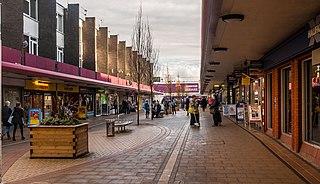
Swinton is a town in the City of Salford in Greater Manchester, England. southwest of the River Irwell, 4 miles (6.4 km) northwest of Manchester, adjoining the town of Pendlebury and suburb of Clifton. In 2014, it had a population of 22,931.

Old Trafford is an area of Trafford, Greater Manchester, England, which borders the cities of Manchester and Salford and is two miles (3.2 km) southwest of Manchester city centre. It is roughly delineated by two old toll gates; Brooks's Bar and Trafford Bar, to the east and west.

Kearsley is a town in the Metropolitan Borough of Bolton, Greater Manchester, England. The population at the 2011 census was 14,212. Within the Historic County of Lancashire, it lies 8 miles (13 km) northwest of Manchester, 5 miles (8 km) southwest of Bury and 3+3⁄4 miles (6 km) south of Bolton.

Broughton is a suburb and district of Salford, Greater Manchester, England. Located on the east bank of the River Irwell, it is 1 mile (1.6 km) northwest of Manchester and 2 miles (3.2 km) south of Prestwich.
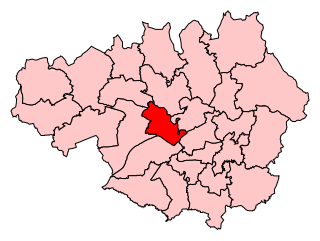
Salford and Eccles is a constituency represented in the House of Commons of the UK Parliament since 2015 by Rebecca Long-Bailey, a member of the Labour Party.
Irlams o' th' Height is a suburb of Salford, Greater Manchester, England. It is located on top of the Irwell Valley, on higher ground than Pendleton, hence the reference to The Height. The first part of the name derives from the Irlam family that ran the Pack Horse Inn in the 17th and 18th centuries.

The architecture of Manchester demonstrates a rich variety of architectural styles. The city is a product of the Industrial Revolution and is known as the first modern, industrial city. Manchester is noted for its warehouses, railway viaducts, cotton mills and canals – remnants of its past when the city produced and traded goods. Manchester has minimal Georgian or medieval architecture to speak of and consequently has a vast array of 19th and early 20th-century architecture styles; examples include Palazzo, Neo-Gothic, Venetian Gothic, Edwardian baroque, Art Nouveau, Art Deco and the Neo-Classical.
Nigel Pivaro is an English actor and journalist. He is best known for playing Terry Duckworth, the son of Jack and Vera Duckworth in Coronation Street.
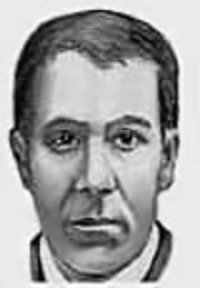
Mark Anthony Addy AM was a publican and champion oarsman, from Manchester, England, who was awarded the Albert Medal (AM), and a number of other honours, for the rescue of over 50 people from the then highly polluted River Irwell in the 19th century. The Albert Medal was later superseded by the George Cross as the highest civilian or non-combat gallantry award in the British honours system.
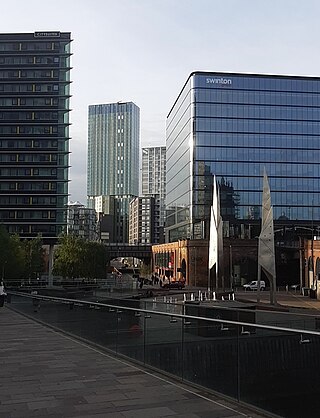
Greengate is an inner-city suburb of Salford in Greater Manchester, England. It is bounded by the River Irwell, Victoria Bridge Street and Chapel Street, Blackfriars Road and Trinity Way. Greengate is the original historic core of Salford and sits within the easternmost part of the City of Salford. Greengate is currently experiencing a period of intensive development activity and growth, benefiting from its location just across the River Irwell from the City of Manchester.

St Clement's Church is a Grade II listed building on Hulton Street, Ordsall, Salford, Greater Manchester, England. It is an active Anglican parish church in the Anglican Diocese of Manchester.

There are 48 Grade I listed buildings in Greater Manchester, England. In the United Kingdom, the term listed building refers to a building or other structure officially designated as being of special architectural, historical or cultural significance; Grade I structures are those considered to be "buildings of exceptional interest". In England, the authority for listing under the Planning Act 1990 rests with Historic England, a non-departmental public body sponsored by the Department for Culture, Media and Sport.
All Hallows RC High School is a mixed Roman Catholic secondary school in the Pendleton area of Salford, Greater Manchester, England.




















